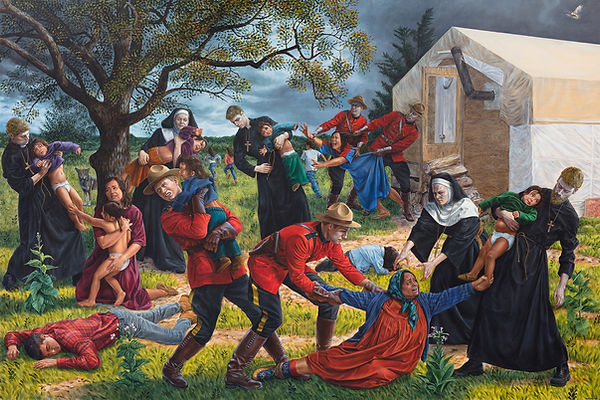
Where Are Prisons?
While prisons themselves may exist as one structural entity, there are many ways that police and prisons, and their focus on surveillance and punishment, emerge in a variety of structures that often go unnoticed.
Residential Schools
We cannot look at the similarities between contemporary education systems and prisons without first understanding Residential Schools in Canada. While they were deemed ‘educational’ by settlers, the ‘schools’ were, in actuality, an embodiment of colonial prisons. Children were taken from their families and forced to live in conditions where their identity, individuality and protection were stripped from them.
Created to assimilate Indigenous peoples into the dominant culture, Residential Schools were a government-funded ‘educational’ system whose purpose was to ‘kill the Indian in the child’. Believing that Indigenous peoples were uncivilized, “the federal government was responsible for funding and setting general policy for the school system, while the churches oversaw the day-to-day operations of the institutions,” (Frideres 61). These schools operated in Canada for over 100 years, and in that time, many Indigenous peoples and their descendants were subjected to intense trauma and torture, isolation, experimentation, sexual and physical abuse, and death.

"The Scoop," Kent Monkman, 2018.
By the 1920’s, attendance at Residential schools was mandatory for Indigenous children. Children as young as 7 years old were forcibly removed from their homes. They were taken from their parents, from their culture, and deposited in Residential Schools where they were made to live in cramped, overcrowded conditions, with little access to food. Once there, children were subjected to intense ‘retraining’, where they were punished and beaten and abused severely if they deviated from the teachings of the Christian church and Canadian culture. Any cultural belongings were forcibly removed, speaking in their Indigenous languages was prohibited, and children quickly learned that to practice their culture was to risk severe punishment.
As a result, generations of Indigneous peoples have long-lasting trauma and a disconnect from their culture that has followed them for generations. Many have difficulties connecting with the world around them, and many have strained relationships with their families and culture. The trauma of Residential Schools has been long-lasting, especially considering that the last school only closed its doors in 1996.
Residential Schools are the most clear-cut example of prisons in schooling. We see a group of people whose children were removed from every chance of stability that they had. They were ripped from their parents, their homes, their land, their families, their culture, and their very language. They were segregated based on sex, and they suffered intense reprogramming of ideals under a constantly-looming threat of violence. Every action that these children took was highly regimented by the Christian church and the federal government. They were constantly under surveillance and were often punished at the drop of a hat. Beatings were routine. Many tried to escape and were killed in the process, and all under the so-called benevolent hand of the government.
These are themes that we see reflected in prison systems. We see themes of isolation and abuse, and of being subjected to the whims of a dominant power. We see all sense of autonomy being removed from the people affected and we see severe consequences for noncompliance.
To this day, Indigenous peoples have a very strained relationship with police and prisons. There are a disproportionate number of Indigenous peoples in Canadian prisons currently, and even now the Canadian government denies any claim to Indigenous sovereignty. While the federal government has acknowledged its participation in the Residential Schooling system, it has made no attempt to reconcile with Indigenous peoples in ways that they have chosen. Instead, like a prison system, the federal government has dictated the terms of reconciliation.
Other Resources